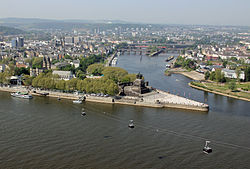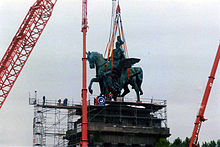- Deutsches Eck
-
For the transport link from Salzburg to West Austria through the southeast corner of Germany, see Deutsches Eck (transport link).
Deutsches Eck ("German Corner") is the name of a headland in Koblenz where the Moselle joins the Rhine. In 1897, nine years after the death of the German Emperor William I, the former emperor was honoured with a giant equestrian statue bearing an inscription quoting a German poem: "Nimmer wird das Reich zerstöret, wenn ihr einig seid und treu" (Never will the Empire be destroyed, so long as you are united and loyal). Another inscription could be found at the statue dedicating it to “Wilhelm der Große” (William the Great).
In 1945, the statue was badly damaged by an American artillery shell. Soon afterwards it was completely taken down. The French military government planned to replace the old memorial with a monument for peace and understanding among nations, but this concept was never realized.
After the formation of the Federal Republic of Germany and the German Democratic Republic in 1949, the country was divided into a capitalist west and a communist east. In order to express the deep wish for a united Germany[citation needed], President Theodor Heuss turned the German Corner into a monument to German unity. As a result, the coats of arms of all German Länder (states), including those of former German territories such as Silesia, East Prussia and Pomerania, were installed. Replacing the destroyed equestrian statue, a German flag flew over the plaza.
After the Berlin Wall came down in November 1989, three concrete parts of the actual wall were installed next to the monument. On 3 October 1990, the emblems of the new federal states were added.
Reinstallation of statue
With German Reunification in 1990, the German Corner no longer served as a symbol of the apiration for a united Germany. Thus, a discussion arose regarding a remodelling of the plaza. Critics considered the reinstallation of the equestrian statue of Wilhelm I as out of time and improper, whereas promoters saw the opportunity for tourist benefits. As the owner of the site, any decision to reinstall a statue of Wilhelm I rested with the government of the Rhineland-Palatinate. However, the state government transferred its rights to the city of Koblenz and when Werner and Anneliese Theisen (a couple from Koblenz) announced that they would bear all costs for a reconstruction of the statue, the decision was made to proceed.
The Düsseldorf sculptor, Raymond Kittl, was commissioned to produce a replica of the original sculpture and the remodelled statue was created from durable bronze cast unlike the original which had been made from copper plates. In May 1992, the parts of the statue were brought to Koblenz on board the MS Futura. The assembly work was completed at the port and on 2 September 1993 a mobile lattice boom crane lifted the statue onto the base. The installation took place on Sedan Day, which although no longer officially recognized, was the day on which the German victory in the Battle of Sedan was commemorated. On 25 September 1993, the new statue was inaugurated.
Today, a big national flag and the flags of the 16 Länder are flying at the German Corner as a reminder of German unity. The three parts of the Berlin Wall are now dedicated to the "victims of the separation".
Image gallery
-
President Hindenburg visits the German Corner
The Deutsches Eck is also a place on Germany's inland waterway system where great skill is needed when making a turn, as the following gallery makes clear.
- A passenger ship deftly steers round the Deutsches Eck.
External links
Wikimedia Foundation. 2010.


















